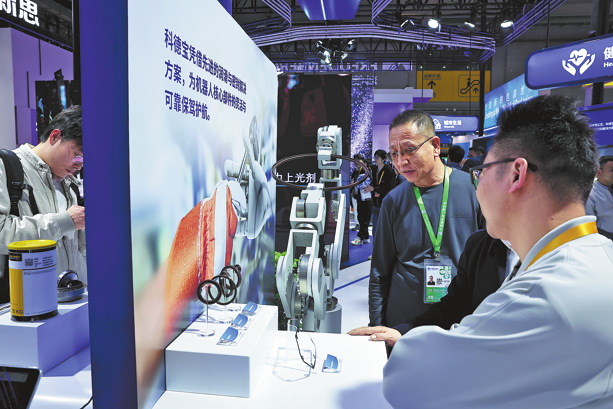Nation offering great opportunities for global biz
Eighth CIIE attracted more than 4,000 companies from 155 countries, regions and international organizations; saw deepened cooperation and record new deals


Plump, meaty, and rich in roe, the Norwegian brown crab — often called the king crab — has received the green light to enter the Chinese market. The announcement came on Nov 7 from Hanne-Berit Brekken, state secretary of the Norwegian Ministry of Agriculture and Food, who spoke at the Norway Pavilion of the CIIE.
"Norway has always viewed China as one of its most promising and dynamic markets," said Sigmund Bjorgo, China director of the Norwegian Seafood Council. "After five consecutive years of participating in the CIIE, China has become Norway's third-largest seafood export market globally and the fastest-growing in export value."
To capture even more of that potential, the council plans to increase its marketing budget for China by 70 percent next year, according to Bjorgo.
In a world navigating the hidden reefs of unilateralism and a thickening fog of geopolitical rivalry, the CIIE offers a tangible counter-narrative — one where openness, not isolation, is presented as the path to shared growth, said Zhou Mi, a researcher at the Chinese Academy of International Trade and Economic Cooperation.
By leveraging the vast scale and stability of the Chinese market, the expo provides a crucial platform for businesses worldwide to mitigate international volatility, Zhou added.
According to the World Openness Report 2025 released earlier this month, the World Openness Index registered a marginal decline of 0.05 percent in 2024 compared to the previous year, reflecting drops of 0.34 percent from 2019 and 5.39 percent from 2008, respectively.
"Global openness remains in a contraction phase," said Liao Fan, director of the Chinese Academy of Social Sciences' Institute of World Economics and Politics.
Europe, Central Asia and North America emerged as the only regions experiencing a contraction in openness, while emerging markets and developing economies saw their openness index rise 0.42 percent year-on-year, the report noted.
Between 1990 and 2024, China's openness index surged from 0.59 to 0.76, marking a rise of nearly 30 percent. This robust expansion underscores China's commitment to high-standard opening-up, injecting much-needed stability and certainty into the world economy, Liao said.
Faced with a protectionist wall in the West, Ron Lin, founder and president of a honey product company from Canada, and many other global business leaders are walking through a door China has always held open.
"The United States was originally our major market," said Lin. "But since the tariff hikes, we have suspended most of our orders to the US — the uncertainty there is just too strong."
"China is proactively opening its door through platforms like the CIIE," he said, highlighting not only streamlined Customs and logistics services, but also a clear and welcoming attitude he finds lacking elsewhere.
In his company's first appearance at the CIIE in 2024, it selected three flagship honey products for the Chinese market. For this year, it had prepared an even wider array of new items to test the waters.
"We are full of confidence in the potential of the Chinese market," Lin stated. "Given its population base, the Chinese market has every possibility of surpassing the US market in the long run."
The expo saw robust transaction activity, with intended deals reaching a record $83.49 billion on an annualized basis, a 4.4 percent increase from the previous edition, Wu Zhengping, deputy director-general of the CIIE Bureau, told a news conference after the conclusion of the event.
The expo has long been a showcase for global brands to present their latest products. But for a growing number of multinational firms, it has become something more strategic, a launchpad for deep integration into the Chinese economy.
This shift was crystallized on the first day of this year's expo, when Porsche opened its China R&D Center in Shanghai's Hongqiao International Central Business District, designed to accelerate local innovation by merging Porsche's engineering capability with China's fast-paced digital ecosystem.
























